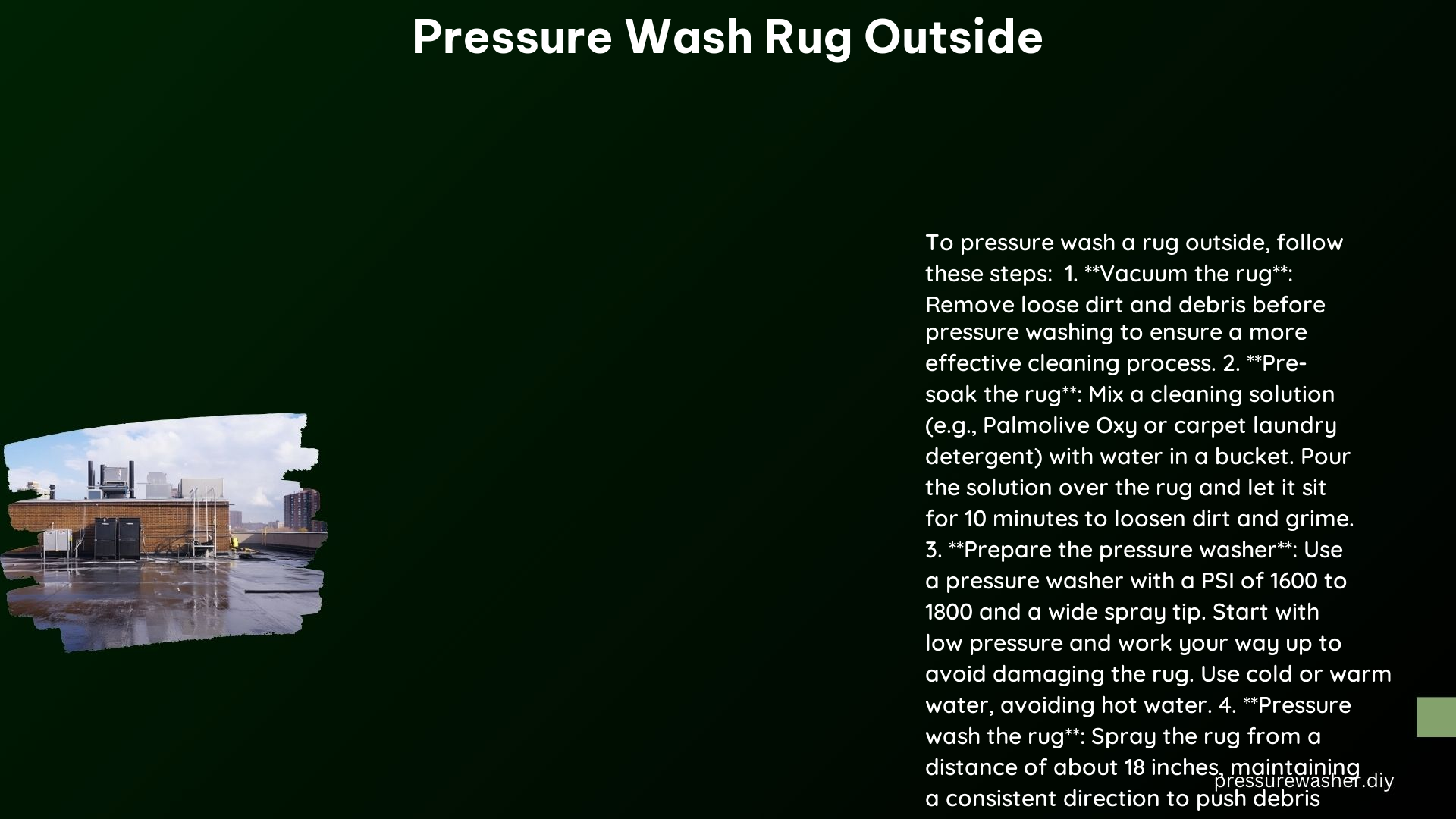Pressure washing a rug outside can be an effective and efficient way to deep clean and revive your outdoor carpets. This comprehensive guide will walk you through the step-by-step process, providing technical specifications and expert tips to ensure a successful and damage-free rug cleaning experience.
Prepare the Rug for Pressure Washing
Before you begin the pressure washing process, it’s crucial to properly prepare the rug. This step will help loosen and remove any accumulated dirt, debris, and grime, making the pressure washing more effective.
-
Vacuum the Rug Thoroughly: Start by thoroughly vacuuming the rug to remove any loose dirt, dust, and debris. This will help prevent the pressure washer from simply pushing the surface-level dirt back into the rug fibers.
-
Pre-soak the Rug: Next, pre-soak the rug with a cleaning solution. Recommended solutions include Palmolive Oxy or a carpet laundry detergent. Allow the rug to soak for approximately 10 minutes, which will help break down and loosen any stubborn dirt and grime.
Set Up the Pressure Washer

Selecting the right pressure washer and setting it up correctly is essential for a successful rug cleaning. Here are the key considerations:
- Pressure Washer Specifications:
- Use a pressure washer with a PSI (Pounds per Square Inch) rating between 1600 to 1800.
-
Equip the pressure washer with a wide spray tip to avoid damaging the delicate rug fibers.
-
Water Temperature:
- Use cold or warm water for the pressure washing process.
- Avoid using hot water, as it can potentially cause damage to the rug’s materials and dyes.
Pressure Wash the Rug
With the rug prepared and the pressure washer set up, it’s time to begin the pressure washing process. Follow these guidelines to ensure a thorough and effective clean:
- Maintain Proper Distance:
- Hold the pressure washer nozzle approximately 18 inches away from the rug’s surface.
-
Maintain a consistent distance to avoid pushing debris back into the rug.
-
Directional Consistency:
- Move the pressure washer in a consistent direction, either horizontally or vertically, to ensure even coverage.
-
Avoid sudden changes in direction, as this can push dirt and debris back into the rug.
-
Avoid the Backside:
-
Refrain from spraying the backside of the rug, as this can potentially damage the backing or cause water to seep through.
-
Edge Caution:
- Be extra cautious when pressure washing the edges of the rug, as they are more susceptible to damage.
- Reduce the pressure or use a gentler spray pattern when cleaning the edges.
Rinse and Dry the Rug
After the pressure washing is complete, it’s essential to thoroughly rinse the rug and allow it to dry completely.
- Rinsing:
- Rinse the rug thoroughly to remove any remaining soap or cleaning solution residue.
-
Ensure that all traces of the cleaning solution are removed to prevent any potential damage or discoloration.
-
Drying:
- Allow the rug to dry completely, which can take 24 to 48 hours depending on the size and material of the rug.
- To speed up the drying process, you can drape the rug over outdoor chairs or use a fan to circulate air around the rug.
Technical Specifications
To summarize the key technical specifications for pressure washing a rug outside:
| Specification | Recommended Value |
|---|---|
| Pressure Washer PSI | 1600 to 1800 |
| Spray Tip | Wide Spray Tip |
| Water Temperature | Cold or Warm |
| Drying Time | 24 to 48 hours |
References
- How to Clean an Area Rug with a Pressure Washer
- How to Clean an Area Rug the Fun Way (Hint: Get Out Your Power Washer)
- Turns Out You Can Power Wash Rugs as Well
- Pressure Washing an Area Rug
- How to Clean a Rug with a Pressure Washer
By following the detailed steps and technical specifications outlined in this guide, you can effectively pressure wash your outdoor rugs, restoring their vibrant colors and fresh appearance. Remember to always exercise caution and test the pressure washer on a small, inconspicuous area of the rug before proceeding with the full cleaning process.
